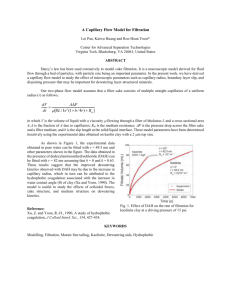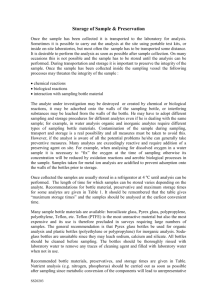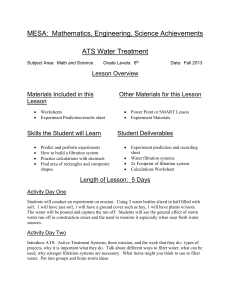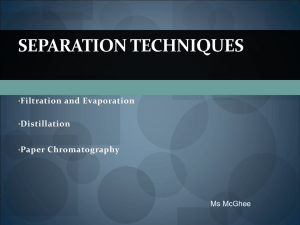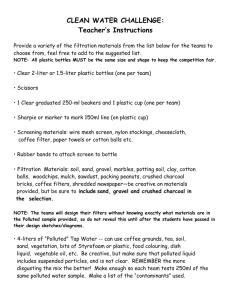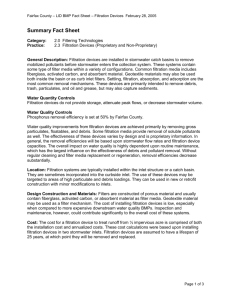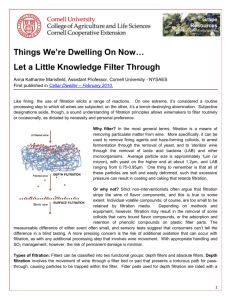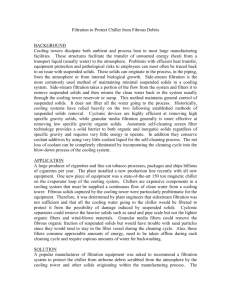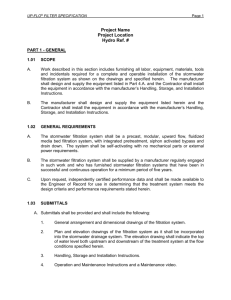Water Treatment
advertisement
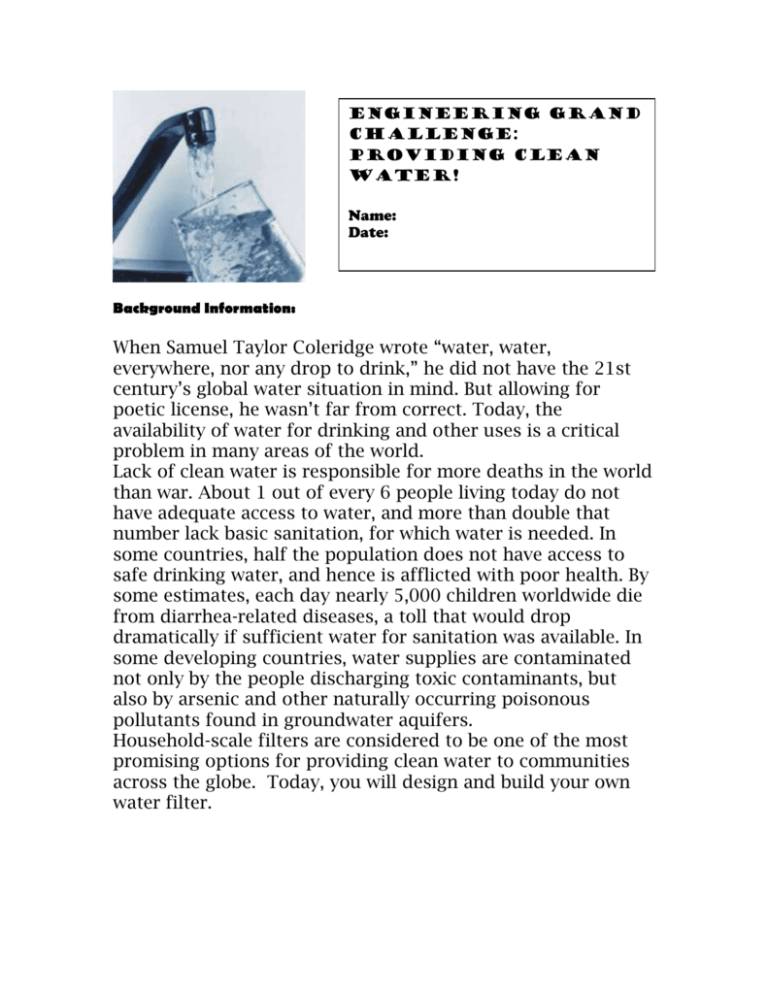
Engineering grand challenge: Providing clean water! Name: Date: Background Information: When Samuel Taylor Coleridge wrote “water, water, everywhere, nor any drop to drink,” he did not have the 21st century’s global water situation in mind. But allowing for poetic license, he wasn’t far from correct. Today, the availability of water for drinking and other uses is a critical problem in many areas of the world. Lack of clean water is responsible for more deaths in the world than war. About 1 out of every 6 people living today do not have adequate access to water, and more than double that number lack basic sanitation, for which water is needed. In some countries, half the population does not have access to safe drinking water, and hence is afflicted with poor health. By some estimates, each day nearly 5,000 children worldwide die from diarrhea-related diseases, a toll that would drop dramatically if sufficient water for sanitation was available. In some developing countries, water supplies are contaminated not only by the people discharging toxic contaminants, but also by arsenic and other naturally occurring poisonous pollutants found in groundwater aquifers. Household-scale filters are considered to be one of the most promising options for providing clean water to communities across the globe. Today, you will design and build your own water filter. Purpose: Millions of people rely solely on groundwater for their drinking water, and nearly everyone relies on groundwater to irrigate farmland. Water is filtered as it flows through the ground, but the type of material through which it flows and the length of flow vary considerably. Even municipal water systems have limited ability to filter water, particularly when the type of contaminant is unknown. Design phase: You will have the following materials available for your filtration system: Materials: • 2-liter plastic bottle • scissors • coffee filters • rubber bands • filtration materials – soil, sand, gravel, marbles, cotton balls, vegetation (shredded lettuce) You may choose up to 3 filtration materials, and you may use them in any order. Things to remember: These systems will be built within plastic bottles like the one your teacher has as a sample. The bottom will be cut off, and a screen will prevent the small opening from spilling filtration materials. Your system will include 3 of the filtration materials provided to you. You will not know what is in the polluted water until after your system is constructed. Review the competition/grading rubric as you design. Note that you will receive points based both on the purity of the water that passes through your filter, as well as how fast your will pass through your filter. Water purity is weighted more, and should therefore be the focus of your thoughts. However, if your sample does not pass through your filter system in 15 minutes, your team is disqualified and will not earn points for water purity. You will also be evaluated on your attitude, team cooperation, timemanagement and overall contribution to your group. Your design should consist of a simple sketch and a short paragraph describing why you used the materials you did, and how the order was chosen on the paper provided. Hand in the design to your teacher. Discuss the details of your design to your class. At this point the teacher will be holding everyone’s designs, so there is no worry of someone stealing your ideas. Paragraph describing why you choose the materials you did, and how the order was chosen: Water Filtration Rubric: CATEGORY 4 Water Quality Very clear, no particles Time 0-60 seconds 3 Clear, some small particles remaining 61-120 seconds 2 Murky, large particles remaining 121-180 seconds 1 No noticeable change from start >181 seconds Participation Rubric: CATEGORY Attitude 4 Never publicly critical of the project or the work of others. Always positive about the task(s). 3 Rarely publicly critical of the project or the work of others. Often positive about the task(s). 2 Occasionally publicly critical of the project or the work of others. Usually positive about the task(s). 1 Often publicly critical of the project or the work of others. Often negative about the task(s). Team Cooperation Almost always listens to, shares with, and supports the efforts of others. Tries to keep people working well together. Usually listens to, shares, with, and supports the efforts of others. Does not cause "waves" in the group. Often listens to, shares with, and supports the efforts of others, but sometimes is not a good team member. Rarely listens to, shares with, and supports the efforts of others. Often is not a good team player. Timemanagement Routinely uses time well throughout the lesson to ensure things get done on time. Group does not have to adjust deadlines or work responsibilities because of this person's procrastination. Usually uses time well throughout the lessons, but may have procrastinated on one thing. Group does not have to adjust deadlines or work responsibilities because of this person's procrastination. Tends to procrastinate, but always gets tasks done by the deadlines. Group does not have to adjust deadlines or work responsibilities because of this person's procrastination. Rarely gets tasks done by the deadlines AND group has to adjust deadlines or work responsibilities because of this person's inadequate time management. Contributions Routinely provides useful ideas to the team. A definite leader who contributes a lot of effort. Usually provides useful ideas to the team. A strong group member who tries hard! Sometimes provides useful ideas to the team. A satisfactory group member who does what is required. Rarely provides useful ideas to the team. May refuse to participate or give up at times. Build phase: o Cut the top off of your plastic bottle. o Remove the cap, and rubber band the coffee filter around the neck of the bottle. Turn the top upside down and place in the plastic bottle. o Create your filtration system just as you designed. Each layer should be about 2 inches thick. Testing phase: o Get a sample of water from your teacher. Describe the water (how does it look, smell, what color is it, etc): o Before pouring the polluted sample through your filter, be prepared to 1) start timing to see how long it takes to move through your filter. 2) collect the water flowing through your system. o You may only filter your water once. o Raise your hand and the teacher will come score your finished water based on the rubric. 5. Follow-up. o Complete the follow-up sheet. Name: ________________________Date: ____________________ Water Filtration Follow-up Questions 1. Which of the filtration materials was most effective at filtering your polluted water? Explain why you think this material was the best. 2. If you were to retest with the same polluted water, what changes would you make to your filtration system? (Nothing is not an acceptable answeryou can always improve!) 3. Do you think the order in which you placed your filtering materials made any difference? Explain why or why not. 4. What other objects do you think would improve the physical filtration of the systems built in class? 5. Engineers are constantly working to improve water filtration systems. Why is it important to have clean water? 6. Brainstorm: List two other ways we can provide clean water to place where there isn’t any: 7. Evaluate your contribution to the group: Analytical Instruments: Spectrophotometer—we will use this to measure the amount of particles in suspension. The spectrophotometer can measure the attenuation of a light beam due to scattering (deflection of light from a straight path) or absorption (uptake of light by medium)—here we will assume that light attenuation is due to scattering off particles and that the amount of light lost from the beam is proportional to the amount of solid material in suspension. It will be necessary to teach the students how to use the spectrophotometer. Light scattering is usually measured at relatively long wavelengths, where there is little loss of light due to absorption by dissolved material in water. Here, I recommend a wavelength of λ = 640 nm (nanometers). The spectrophotometer will give you a measurement called absorbance or optical density. At relatively low particle densities, absorbance is related to particle concentration by A=εlc where A is the absorbance reading (here @ 640 nm) l is the light pathlength across a cuvette that fits the instrument (here 1 cm) ε is a constant of proportionality c is the particle concentration in the suspension Figure 1. Schematic diagram of a single-beam spectrophotometer. Spectrophotometer—Can also be used to measure light absorbance in the visible range. Selective absorbance of light energy at specific wavelengths is what produces color. Each color of food dye absorbs a different pattern of light wavelengths in the visible light range. You might check this out in class. Conductivity meter— A conductivity meter works by establishing a known difference in electrical potential across a fixed distance. The fluid in the middle can then conduct charge across that gap. Electrical conductivity (proportional to the current between the electrodes) will be relatively high if there are lots of ions in the fluid to conduct charge or if the fluid is itself polar—like water. Water becomes more conductive as its salt content increases. Again, you might conduct a little experiment measuring the conductivity of water as a function of total salt that is dissolved in it. Instructor Notes: You can prepare your wastewater any way you like- feel free to be creative and add additional elements! Our standard preparation includes cornstarch, food coloring and salt. There is lots of background material that you could prepare and present regarding the sustainability of water supply in the Southwest—who is using our water and where does it come from? There are some scientific issues to expose as well—for example, the mechanisms of particle removal during filtration, how to improve filter performance, Beer’s law for measurement of dissolved organics, how to make a standard curve, etc. All classes are encouraged to modify the experimental procedure as dictated by the capabilities of the class, time restrictions and so forth. Students should be asked to write up the results of their exercises using a standard format—background and objectives (including the hypotheses to be tested, materials and methods, results, and discussion of results. Perhaps the very best of the write ups can then be used as models to show students what works and talk about how to improve their own scientific writing.


